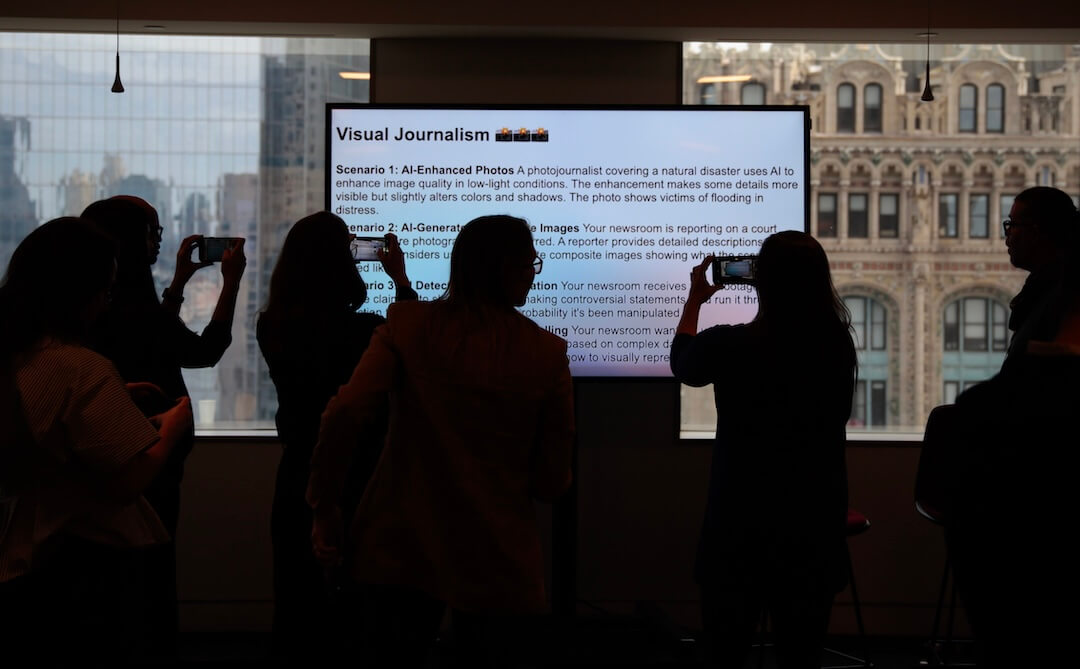One of the most vexing, and even dangerous, issues facing journalists these days is harassment, both online and in real life. Among the best-known examples is New Hampshire Public Radio, whose reporter Lauren Chooljian, along with her editor, Dan Barrick, and her parents were the targets of vandalism to their homes, apparently in retaliation for Chooljian’s reporting. Four New Hampshire men have been indicted by federal authorities and face long prison terms and heavy fines if they are convicted.
Harassment has been emerging as an issue in journalism education as well. I’ve been trying to find ways of dealing with it in my undergraduate and graduate ethics classes. A year ago, I devoted just part of one 100-minute class to the subject. Now I set aside a week — two full classes.
Because I know other journalism instructors are dealing with this, I thought I’d lay out how we handled it in my class just recently. This is ever-evolving, of course, so please consider this one instructor’s attempt to wrestle with a difficult issue.
First, here’s the reading that I assigned:
- “A Reporter Investigated Sexual Misconduct. Then the Attacks Began.,” by David Enrich, The New York Times, June 6, 2023. This is a comprehensive overview of the New Hampshire Public Radio situation.
- “Online mobs are now coming for student journalists,” by Taylor Lorenz, The Washington Post, Nov. 19, 2022. A harrowing story about a student journalist who criticized a campus TikTok influencer, who then turned around and unleashed his mob on her.
- “Felicia Sonmez Is Fired by The Washington Post,” by Katie Robertson, The New York Times, June 9, 2022. Sonmez was back in the news recently, as CNN’s Jake Tapper questioned former Post executive editor Marty Baron about why Sonmez was punished for tweeting about charges of sexual assault against Kobe Bryant in the immediate aftermath of Bryant’s death in a helicopter crash. Sonmez was later fired after the Post claimed she ignored orders from Baron’s successor, Sally Buzbee, to stop criticizing her colleagues on Twitter. (Sonmez and the Washington Post Guild have filed a complaint with the National Labor Relations Board, arguing that she was unlawfully fired for speaking out about working conditions.)
- “We need to teach student journalists about on-the-job harassment,” by Meg Heckman, Myojung Chung and Jody Santos, Poynter, Sept. 14, 2022. Meg, Myo and Jody are colleagues of mine at Northeastern, and they conducted a major study that showed some young journalists, especially women, are giving up their aspirations of working in news because of the harassment they’ve been subjected to.
In the first of my two classes on harassment, I opened with a brief overview of a situation that played out recently at the Las Vegas Review-Journal, where reporter Sabrina Schnur was subjected to frightening online abuse, including antisemitic tweets and death threats, because an online mob wrongly believed she had played down the death of a retired police chief who was killed by a car while riding his bicycle. It later turned out that he may have been run down intentionally, but of course that wasn’t reflected in Schnur’s initial story since it wasn’t known at the time.
The X/Twitter mob, by the way, was unleashed by Elon Musk himself, which at this point should not surprise anyone. A wrinkle that made the Las Vegas situation especially unnerving was that, a year earlier, Review-Journal reporter Jeff German had been stabbed to death by a public official who’d been the subject of German’s reporting.
During that first class we also watched an Al-Jazeera interview with two international women journalists — Nobel Peace Prize winner Maria Ressa of the Philippines and Sagarika Ghose of India — as well as Hannah Storm, then CEO of the International News Safety Institute, about the threats female reporters face while doing their jobs. We then talked about the readings and discussed what newsrooms could do to prevent such harassment and how they should respond when it occurs.
In my second class, I began by discussing a situation I found myself in several years ago, related to my role as a panelist on GBH-TV’s “Beat the Press” (since canceled), in which I became concerned that a Twitter conflagration aimed at me might spill over into real life. I don’t want to compare what I went through with Chooljian’s and Schnur’s terrifying experiences. But it got bad enough that I brought it up with someone at a public library where I would be speaking, and the library decided to request that a police officer be assigned to my talk. (In fact, the event went off without any issues.)
That was followed by a student presentation. Once a week, I ask two students to discuss a topic related to journalism ethics, and that week I asked them in advance to consider a presentation on harassment. They came through with an excellent talk about “Female Journalists & Sexual Harassment.” Next up: A lecture by me on the hazards of social media, including some well-known examples involving journalists such as Wesley Lowery, Jemele Hill and Julia Ioffe.
We closed our second class with a guest talk by my Northeastern colleague Jody Santos, the co-author of the Poynter article listed above, who helped further define harassment and discussed what could be done about it.
But the most useful part came outside of class. Every week we have an online discussion about whatever topic we’ve been dealing with in class. After our two classes on harassment, I asked my students to write a 200- to 300-word comment in the form of a memo to the director of our School of Journalism, Jonathan Kaufman, suggesting ways that our program could prepare students to deal with the harassment that journalists sometimes face on the job, both online and in real life.
The answers were detailed and thought-provoking, and I would expect no less of our students. Probably the most actionable ideas involved setting up a panel discussion about the issue; pushing harassment training further down in the curriculum so that students have a chance to engage with the topic during their first and second years; and putting together a list of resources that students and faculty members could use when a student journalist is harassed.
“Ensure that students are taught about harassment in introductory classes so they understand it before it potentially happens to them,” wrote one student.
Said another: “There is a preconceived notion that journalists must have a thick skin and have to ‘toughen up’ to perform well in their roles. However, this idea … may deter students from reporting harassment because they do not want to be seen as weak.”
I think we’ve got a long way to go. As it stands, no one quite seems to know what to do about journalism and harassment, whether you’re talking about J-school curriculums or major news organizations. It’s one thing to define and discuss the problem; it’s another to solve it. But I hope that simply bringing this out into the open will help us all to understand how extensive this has become and to begin finding some workable strategies.
Editor’s note: This story was changed from its original wording in describing Sonmez’s career path and to include additional context about a grievance she filed after she was fired, following a review of objections from Sonmez to some of the phrasing.







